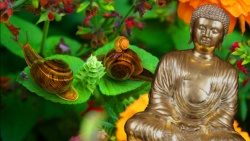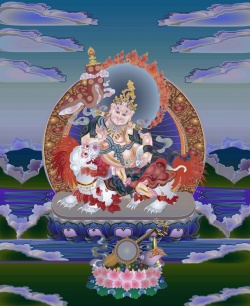Difference between revisions of "Treta Yuga"
(Created page with "{{DisplayImages|1999|712}} Treta Yuga (Devanagari: {{SanskritBig|त्रेता युग}}) is the second out of four yugas, or ages of mankind, in the religion o...") |
|||
| Line 1: | Line 1: | ||
{{DisplayImages|1999|712}} | {{DisplayImages|1999|712}} | ||
| − | [[Treta Yuga]] (Devanagari: {{SanskritBig|[[त्रेता युग]]}}) is the second out of four yugas, or ages of mankind, in the religion of Hinduism. Treta means, third in Sanskrit. The first yuga is Satya Yuga of perfect morality and the one after Treta is the Dvapara Yuga. The most famous events in this yuga were Lord Vishnu's fifth, sixth and seventh incarnations as Vamana, Parashurama and Rama respectively. The Dharma bull, which symbolises morality, stood on three legs during this period. It had all four in the Satya Yuga and two in the later Dvapara Yuga. Currently, in the immoral age of Kali, it stands on one leg. The Treta Yuga lasted 1,296,000 years. | + | [[Treta Yuga]] ({{Wiki|Devanagari}}: {{SanskritBig|[[त्रेता युग]]}}) is the second out of four [[yugas]], or ages of mankind, in the [[religion]] of [[Hinduism]]. Treta means, third in [[Sanskrit]]. The first [[yuga]] is [[Satya Yuga]] of perfect [[morality]] and the one after Treta is the [[Dvapara Yuga]]. The most famous events in this [[yuga]] were [[Lord]] [[Vishnu's]] fifth, sixth and seventh [[incarnations]] as Vamana, Parashurama and {{Wiki|Rama}} respectively. The [[Dharma]] [[bull]], which symbolises [[morality]], stood on three {{Wiki|legs}} during this period. It had all four in the [[Satya Yuga]] and two in the later [[Dvapara Yuga]]. Currently, in the [[immoral]] age of [[Kali]], it stands on one leg. The [[Treta Yuga]] lasted 1,296,000 years. |
| − | ==Avatars of Vishnu during Treta Yuga== | + | ==[[Avatars]] of [[Vishnu]] during [[Treta Yuga]]== |
===Vamana=== | ===Vamana=== | ||
| − | Vishnu incarnated as the dwarf son of Aditi to stop King Mahabali of the Asura race, the grandson of Prahlada, from completing a sacrifice which would allow him to overshadow Indra in power and splendor. The jealous and worried Devas persuaded Vishnu to send Bali, a bhakta of his, to Patala, the underworld. Vishnu did so by taking advantage of the King's kindness and refusal to go back on his word, but allowed him a luxurious dwelling and sovereignty in one of the lower worlds. He also gave him the boon of being able to visit his subjects once every year which is celebrated in onam festival. | + | [[Vishnu]] [[incarnated]] as the {{Wiki|dwarf}} son of [[Aditi]] to stop [[King]] Mahabali of the [[Asura]] race, the grandson of [[Prahlada]], from completing a {{Wiki|sacrifice}} which would allow him to overshadow [[Indra]] in power and splendor. The [[jealous]] and worried [[Devas]] persuaded [[Vishnu]] to send [[Bali]], a [[bhakta]] of his, to [[Patala]], the {{Wiki|underworld}}. [[Vishnu]] did so by taking advantage of the King's [[kindness]] and refusal to go back on his [[word]], but allowed him a luxurious dwelling and {{Wiki|sovereignty}} in one of the [[lower worlds]]. He also gave him the boon of being able to visit his [[subjects]] once every year which is celebrated in onam {{Wiki|festival}}. |
===Parashurama=== | ===Parashurama=== | ||
| − | Vishnu incarnated as the Brahmana Parashurama in this era because there were too many warlike kshatriyas plaguing the Earth, and he therefore had to wipe out most of the world's warriors. However, some of the Kshatriyas survived or more were created, and their population grew again. Eventually, the avatara of Vishnu in Parashurama ended, though it is said that he continued to live on as a mighty warrior-hermit. He confronted Rama angrily years later, before acknowledging the latter's supremacy and retiring. He lived on in the Dvapara Yuga, having a great duel with Bhishma for Amba's sake, however he failed to defeat him and stopped fighting after he was forbidden by Pitrs and his ancestors and learning that Bhishma had surpassed him in art of warfare He mentored Drona, the teacher of both Kauravas and Pandavas .Parshurama also taught Karna how to use the Brahmastra but when he found out that he was not a Brahmin but a kshatriya, he cursed him that his knowledge of the Brahmastra will fail him when.most crucial since he had vowed not to teach or be a Guru of Kshatriyas. He is said to be still alive today, doing penance on Mahendragiri. | + | [[Vishnu]] [[incarnated]] as the [[Brahmana]] Parashurama in this {{Wiki|era}} because there were too many warlike {{Wiki|kshatriyas}} plaguing the [[Earth]], and he therefore had to wipe out most of the world's {{Wiki|warriors}}. However, some of the {{Wiki|Kshatriyas}} survived or more were created, and their population grew again. Eventually, the [[avatara]] of [[Vishnu]] in Parashurama ended, though it is said that he continued to live on as a mighty warrior-hermit. He confronted {{Wiki|Rama}} angrily years later, before [[acknowledging]] the latter's supremacy and retiring. He lived on in the [[Dvapara Yuga]], having a great duel with Bhishma for Amba's sake, however he failed to defeat him and stopped fighting after he was forbidden by Pitrs and his {{Wiki|ancestors}} and {{Wiki|learning}} that Bhishma had surpassed him in [[art]] of warfare He mentored [[Drona]], the [[teacher]] of both [[Kauravas]] and {{Wiki|Pandavas}} .Parshurama also taught {{Wiki|Karna}} how to use the Brahmastra but when he found out that he was not a [[Brahmin]] but a [[kshatriya]], he cursed him that his [[knowledge]] of the Brahmastra will fail him when.most crucial since he had [[vowed]] not to teach or be a [[Guru]] of {{Wiki|Kshatriyas}}. He is said to be still alive today, doing penance on Mahendragiri. |
| − | ===Rama=== | + | ==={{Wiki|Rama}}=== |
| − | The hallmark of this era was the rise of evil in the form of the demon king of Lanka, Ravana. He conquered the three worlds namely, earth, heavens and the netherworlds (patala) and terrorized everyone. Even the Devas were subordinate to him - his son Meghanada had earned the name of Indrajit by defeating Indra, the King of heaven, in battle; and even the Sun had to obey the rakshasa king. In this scenario, Lord Vishnu incarnated himself as the son of King Dasaratha of the Sun Dynasty or Ikshvaku dynasty and was named Lord Rama. Due to a stepmother's jealousy, Lord Rama was sent away to the forest in exile for 14 years, during which time he confronted and killed Ravana for having kidnapped his wife, and thus restored peace on earth. He is said to have afterwards ruled the Kingdom of Kosala from Ayodhya for an eleven-thousand year golden age known as the Rama-rajya or Rama's Kingdom, before eventually returning to his Mahavishnu form with his three half-brothers- Lakshmana, Bharata and Shatrughna- who were "minor" incarnations of Vishnu or the great serpent-gods Shesha. | + | The hallmark of this {{Wiki|era}} was the rise of [[evil]] in the [[form]] of the {{Wiki|demon}} [[king]] of [[Lanka]], [[Ravana]]. He conquered the [[three worlds]] namely, [[earth]], [[heavens]] and the [[netherworlds]] ([[patala]]) and terrorized everyone. Even the [[Devas]] were subordinate to him - his son Meghanada had earned the [[name]] of Indrajit by defeating [[Indra]], the [[King]] of [[heaven]], in {{Wiki|battle}}; and even the {{Wiki|Sun}} had to obey the [[rakshasa]] [[king]]. In this scenario, [[Lord]] [[Vishnu]] [[incarnated]] himself as the son of [[King]] [[Dasaratha]] of the {{Wiki|Sun}} Dynasty or Ikshvaku dynasty and was named [[Lord]] {{Wiki|Rama}}. Due to a stepmother's [[jealousy]], [[Lord]] {{Wiki|Rama}} was sent away to the {{Wiki|forest}} in exile for 14 years, during which [[time]] he confronted and killed [[Ravana]] for having kidnapped his wife, and thus restored [[peace]] on [[earth]]. He is said to have afterwards ruled the {{Wiki|Kingdom}} of [[Kosala]] from [[Ayodhya]] for an eleven-thousand year golden age known as the Rama-rajya or Rama's {{Wiki|Kingdom}}, before eventually returning to his Mahavishnu [[form]] with his three half-brothers- Lakshmana, [[Wikipedia:Bharata (emperor)|Bharata]] and Shatrughna- who were "minor" [[incarnations]] of [[Vishnu]] or the great serpent-gods [[Shesha]]. |
{{W}} | {{W}} | ||
[[Category:Yuga]] | [[Category:Yuga]] | ||
Latest revision as of 20:57, 11 April 2014
Treta Yuga (Devanagari: त्रेता युग) is the second out of four yugas, or ages of mankind, in the religion of Hinduism. Treta means, third in Sanskrit. The first yuga is Satya Yuga of perfect morality and the one after Treta is the Dvapara Yuga. The most famous events in this yuga were Lord Vishnu's fifth, sixth and seventh incarnations as Vamana, Parashurama and Rama respectively. The Dharma bull, which symbolises morality, stood on three legs during this period. It had all four in the Satya Yuga and two in the later Dvapara Yuga. Currently, in the immoral age of Kali, it stands on one leg. The Treta Yuga lasted 1,296,000 years.
Avatars of Vishnu during Treta Yuga
Vamana
Vishnu incarnated as the dwarf son of Aditi to stop King Mahabali of the Asura race, the grandson of Prahlada, from completing a sacrifice which would allow him to overshadow Indra in power and splendor. The jealous and worried Devas persuaded Vishnu to send Bali, a bhakta of his, to Patala, the underworld. Vishnu did so by taking advantage of the King's kindness and refusal to go back on his word, but allowed him a luxurious dwelling and sovereignty in one of the lower worlds. He also gave him the boon of being able to visit his subjects once every year which is celebrated in onam festival.
Parashurama
Vishnu incarnated as the Brahmana Parashurama in this era because there were too many warlike kshatriyas plaguing the Earth, and he therefore had to wipe out most of the world's warriors. However, some of the Kshatriyas survived or more were created, and their population grew again. Eventually, the avatara of Vishnu in Parashurama ended, though it is said that he continued to live on as a mighty warrior-hermit. He confronted Rama angrily years later, before acknowledging the latter's supremacy and retiring. He lived on in the Dvapara Yuga, having a great duel with Bhishma for Amba's sake, however he failed to defeat him and stopped fighting after he was forbidden by Pitrs and his ancestors and learning that Bhishma had surpassed him in art of warfare He mentored Drona, the teacher of both Kauravas and Pandavas .Parshurama also taught Karna how to use the Brahmastra but when he found out that he was not a Brahmin but a kshatriya, he cursed him that his knowledge of the Brahmastra will fail him when.most crucial since he had vowed not to teach or be a Guru of Kshatriyas. He is said to be still alive today, doing penance on Mahendragiri.
Rama
The hallmark of this era was the rise of evil in the form of the demon king of Lanka, Ravana. He conquered the three worlds namely, earth, heavens and the netherworlds (patala) and terrorized everyone. Even the Devas were subordinate to him - his son Meghanada had earned the name of Indrajit by defeating Indra, the King of heaven, in battle; and even the Sun had to obey the rakshasa king. In this scenario, Lord Vishnu incarnated himself as the son of King Dasaratha of the Sun Dynasty or Ikshvaku dynasty and was named Lord Rama. Due to a stepmother's jealousy, Lord Rama was sent away to the forest in exile for 14 years, during which time he confronted and killed Ravana for having kidnapped his wife, and thus restored peace on earth. He is said to have afterwards ruled the Kingdom of Kosala from Ayodhya for an eleven-thousand year golden age known as the Rama-rajya or Rama's Kingdom, before eventually returning to his Mahavishnu form with his three half-brothers- Lakshmana, Bharata and Shatrughna- who were "minor" incarnations of Vishnu or the great serpent-gods Shesha.

